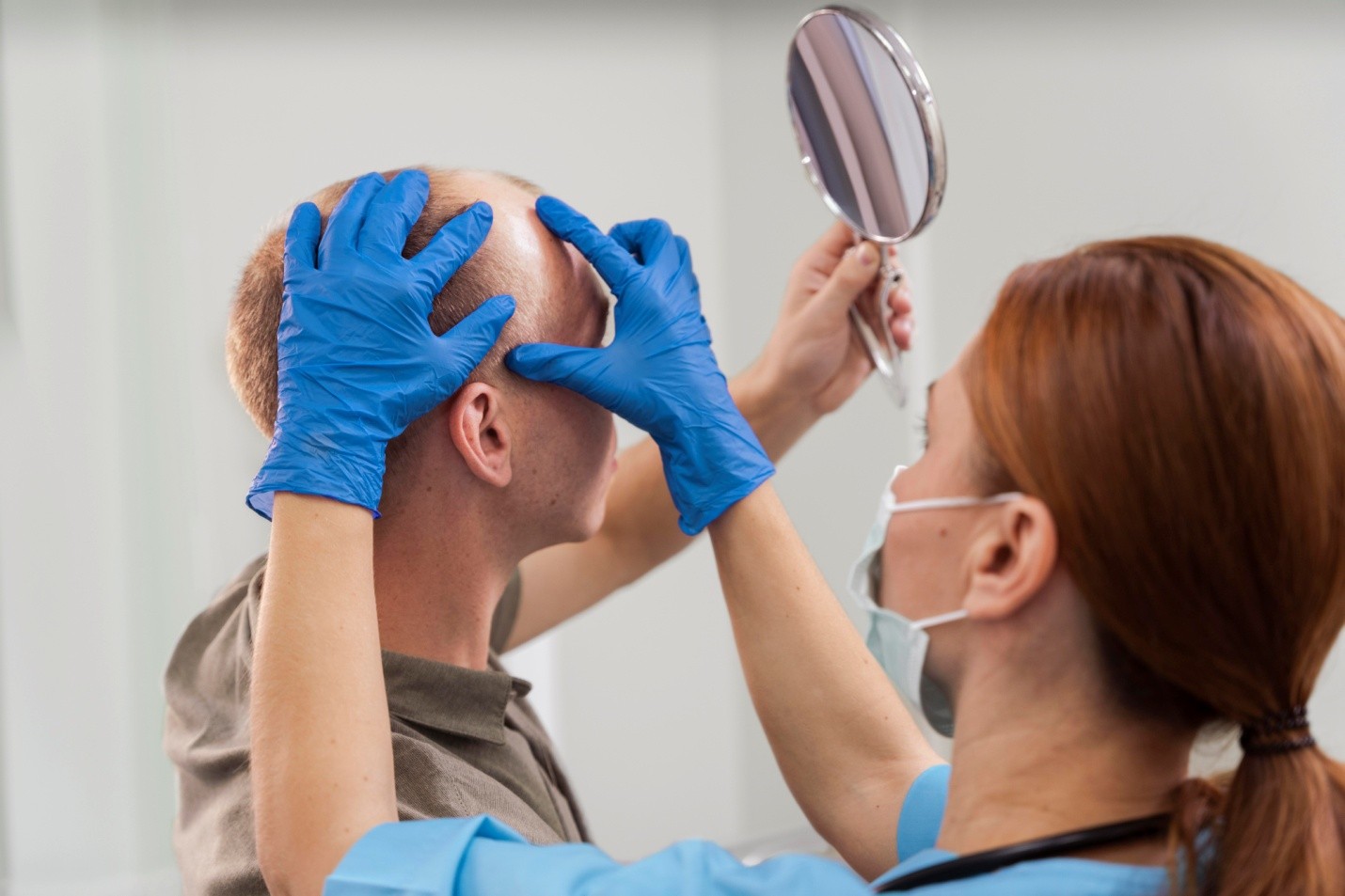What Is FUE Hair Transplant? A Modern Solution for Hair Loss
Hair loss is a deeply personal issue that can affect confidence, emotional well-being, and even how individuals engage with others. While some accept it as a natural part of aging, others seek solutions to regain their natural hair and self-esteem. Thanks to advancements in medical science, Follicular Unit Extraction (FUE) has become one of the most trusted, effective, and minimally invasive methods for restoring hair.
If you’ve been exploring treatment options for hair thinning or baldness, understanding how FUE works is essential. This guide explains the FUE technique, how it compares to older methods, what to expect before and after the procedure, and how it helps create natural-looking, long-lasting results.


Understanding the Root of Hair Loss
Hair loss occurs for a variety of reasons, including:
- Genetic factors, such as androgenetic alopecia (pattern baldness)
- Hormonal changes
- Stress or trauma
- Scalp infections or diseases
- Nutritional deficiencies
- Medical treatments or medications
While some causes are temporary or reversible, many forms of hair loss are permanent and progressive. For these cases, hair transplant surgery may offer the best long-term solution.
What Is FUE Hair Transplant?
Follicular Unit Extraction (FUE) is a modern hair transplant technique in which individual hair follicles are extracted from a healthy area of the scalp—typically the back or sides—and implanted into areas with thinning or no hair. This technique replaces older methods that required removing entire strips of scalp tissue.
The FUE method uses very fine instruments, often less than 1 mm in diameter, to extract hair follicles one by one. These follicles are then precisely placed into tiny incisions made in the area requiring coverage. The results mimic natural hair growth in both appearance and direction.
How the FUE Process Works
Here’s how a typical FUE hair transplant procedure unfolds:
Initial Evaluation
The journey begins with an assessment of the patient’s scalp, pattern of hair loss, and donor hair density. This helps determine whether FUE is a suitable option and how many follicles are needed to achieve the desired result.
Preparation
The donor area—usually the back or sides of the head—is trimmed short to provide better access for follicle extraction. Both the donor and recipient areas are cleaned and numbed with local anesthesia to ensure comfort.
Extraction of Hair Follicles
A handheld or automated tool is used to extract individual hair follicles with great precision. This part of the procedure is performed slowly and carefully to ensure the maximum survival of each follicle.
Implantation into the Recipient Area
Tiny incisions are made in the bald or thinning areas, and the extracted follicles are inserted one by one. The placement considers the natural growth pattern, angle, and density for a realistic outcome.
Post-Procedure Care
After implantation, the scalp is gently cleaned, and specific aftercare instructions are provided. Healing begins quickly, and most patients resume daily activities within a few days.
Benefits of FUE Hair Transplant
FUE is popular for several important reasons:
Minimally Invasive
There are no cuts, stitches, or large incisions. The procedure uses small, circular punches that heal quickly and leave minimal trace behind.
No Linear Scars
Unlike older strip techniques that leave noticeable scars, FUE results in tiny dot-like marks that are often undetectable, especially with longer hair.
Natural-Looking Results
Because follicles are placed individually and at precise angles, the outcome closely resembles natural hair growth—particularly in the hairline and crown.
Quick Recovery Time
Most patients experience only minor swelling or redness, which typically resolves within a week. Many resume normal activities within a few days.
Versatile Application
FUE can be used to restore hair not only on the scalp but also on eyebrows, beard, and even in areas affected by scarring or previous surgeries.
Who Can Benefit from FUE?
FUE hair transplant may be a suitable option for people who:
- Have visible thinning or bald patches
- Have adequate donor hair on the sides or back of the scalp
- Are looking for a natural-looking, minimally invasive solution
- Prefer to avoid large scars
- Have had previous hair restoration procedures that need refinement
It's important to note that FUE may not be ideal for everyone. A thorough consultation helps determine if the method is appropriate based on hair type, scalp condition, and goals.
After the Procedure: What to Expect
Initial Recovery
- Mild redness, swelling, or scabbing may appear but usually clears within days.
- Washing the scalp gently and avoiding sun exposure are key during early recovery.
- Sleeping with the head elevated for the first few nights is often recommended.
Shedding Phase
It’s completely normal for the transplanted hairs to fall out within the first few weeks. This is a temporary phase called "shock loss" and is part of the natural cycle of hair regrowth.
New Hair Growth Timeline
- 3–4 months: Fine new hairs begin to emerge.
- 6 months: Noticeable improvement in density and texture.
- 9–12 months: Final results become visible, with full thickness and maturity.
The timeline can vary slightly from person to person, but patience is key to seeing the final outcome.
Comparing FUE with Older Methods
Before FUE, the most common technique was Follicular Unit Transplantation (FUT), which involves removing a strip of scalp and dissecting it into grafts. Here's how FUE stands out:
- No large scars: FUE avoids the linear scar that often results from FUT.
- Faster healing: Small punctures from FUE heal more quickly than sutures from strip surgery.
- Less discomfort post-op: Most patients report less pain and shorter recovery time.
- Better for active lifestyles: FUE is often preferred by people who are physically active or wear shorter hairstyles.
While both techniques can be effective, FUE is widely favored for its minimally invasive nature and aesthetic advantages.
Are There Any Risks?
FUE is generally safe when performed by experienced professionals. However, as with any medical procedure, there are potential risks, such as:
- Minor infection or inflammation of hair follicles
- Temporary numbness or tingling in the donor area
- Uneven or patchy hair growth if aftercare is not followed
- Graft failure in rare cases
Following pre- and post-operative instructions and ensuring that the procedure is done by trained specialists significantly reduces these risks.
Advancements in FUE Technology
The field of hair transplantation is constantly evolving. Some of the most recent innovations include:
- Robotic-Assisted FUE: Robotics assist in graft extraction, improving precision and speed.
- Sapphire Blade Incisions: These tools create finer incisions, potentially promoting faster healing.
- Long Hair FUE: In select cases, follicles can be extracted and transplanted without shaving the donor area, providing immediate visual results.
Such advancements continue to improve the comfort, accuracy, and outcomes of FUE procedures.
Final Thoughts
Hair loss can be a challenging experience, but it doesn’t have to be permanent. The FUE hair transplant technique offers a scientifically advanced, minimally invasive, and highly personalized solution for those seeking to restore their hair and confidence.
By focusing on natural growth patterns and using the body’s own follicles, FUE produces results that blend seamlessly with existing hair. Whether you're dealing with a receding hairline, thinning crown, or facial hair gaps, FUE may be the modern, long-lasting solution you've been searching for.

